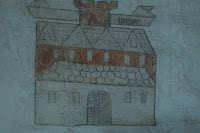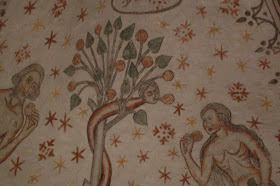

 The church in Vigersted is inaugurated to Sct. Nicolaus of Myra. It has a Romanesque nave with a Gothic longhouse-choir, tower and porch. The Romanesque nave - from which the longwalls and parts of the west gable still stand - is a granite boulder building with limestone ashlars around windows and doors. The demolished Romanesque choir has had an apse, from which curved ashlars with point-arched friezes are seen in the present east gable, the south door is still in use, while the bricked-up north door is vaguely visible. The nave had four windows, of which the two western are visible above the vaults; they are bricked-up from outside. Before the re-build of the choir and the building of the tower the nave was in the first half of the 1400s equipped with two bays cross vaults, and the west gable was raised with steps and four glares; they are visible from the middle storey of the tower. The west tower was added ab. 1450 in bricks with a stairhouse to the north, which originally had access from the tower room. The porch to the south is from ab. 1500 with a storey-divided glare-gable in sydsjællandsk (South Zealand) type and with old roof work , to the west a roof in monk bricks. Above the door is a carved human limestone head. The earliest extension is the longhouse-choir, which has two large point-arched windows to the south. Its gable has a rich glare-decoration in midtsjællandsk (Mid Zealand) type with a large circle-glare and relief-cross. The east section of the choir inside the church is separated for a sacristy with a crossing cupolar barrel-vault in limestone. Upon the north side of the building are two and on the southside one buttress with wall-curves. In the National Museum is a piece of a glazed floor tile from ab. 1300, and in the south wall of the church are various tiles, fx a lily-frieze from ab. 1550.
The church in Vigersted is inaugurated to Sct. Nicolaus of Myra. It has a Romanesque nave with a Gothic longhouse-choir, tower and porch. The Romanesque nave - from which the longwalls and parts of the west gable still stand - is a granite boulder building with limestone ashlars around windows and doors. The demolished Romanesque choir has had an apse, from which curved ashlars with point-arched friezes are seen in the present east gable, the south door is still in use, while the bricked-up north door is vaguely visible. The nave had four windows, of which the two western are visible above the vaults; they are bricked-up from outside. Before the re-build of the choir and the building of the tower the nave was in the first half of the 1400s equipped with two bays cross vaults, and the west gable was raised with steps and four glares; they are visible from the middle storey of the tower. The west tower was added ab. 1450 in bricks with a stairhouse to the north, which originally had access from the tower room. The porch to the south is from ab. 1500 with a storey-divided glare-gable in sydsjællandsk (South Zealand) type and with old roof work , to the west a roof in monk bricks. Above the door is a carved human limestone head. The earliest extension is the longhouse-choir, which has two large point-arched windows to the south. Its gable has a rich glare-decoration in midtsjællandsk (Mid Zealand) type with a large circle-glare and relief-cross. The east section of the choir inside the church is separated for a sacristy with a crossing cupolar barrel-vault in limestone. Upon the north side of the building are two and on the southside one buttress with wall-curves. In the National Museum is a piece of a glazed floor tile from ab. 1300, and in the south wall of the church are various tiles, fx a lily-frieze from ab. 1550. The front of the communion table is from 1606 with original paintings upon a thin chalk-base. The altar piece is High Renaissance 1601, a Roskilde work, related to the altar piece i Herslev church. Altar chalice from 1689. A strange wine-container from 1639. Altar candelabres,Baroque with a ribbed baluster shaft, ab. 1650-1700. A late Gothic monstrans house, a square-sided oak-block with a roof-shaped top and iron fittings. A Romanesque granite font in Slagelse-type with a fourleaf-clover basin. A Netherland baptismal dish from ab. 1650. A choir arch crucifix, late Gothic ab. 1525 ( two figures from the group are now in the National Museum). A pulpit in early bruskbarok, ab. 1630, related to the pulpit in Jystrup church, but not made by the same master. A parish clerk stool with parts of pew-gables fom 1582. In the door of the nave a door wing fromb. 0-50 with a contemporary door-ring.
The front of the communion table is from 1606 with original paintings upon a thin chalk-base. The altar piece is High Renaissance 1601, a Roskilde work, related to the altar piece i Herslev church. Altar chalice from 1689. A strange wine-container from 1639. Altar candelabres,Baroque with a ribbed baluster shaft, ab. 1650-1700. A late Gothic monstrans house, a square-sided oak-block with a roof-shaped top and iron fittings. A Romanesque granite font in Slagelse-type with a fourleaf-clover basin. A Netherland baptismal dish from ab. 1650. A choir arch crucifix, late Gothic ab. 1525 ( two figures from the group are now in the National Museum). A pulpit in early bruskbarok, ab. 1630, related to the pulpit in Jystrup church, but not made by the same master. A parish clerk stool with parts of pew-gables fom 1582. In the door of the nave a door wing fromb. 0-50 with a contemporary door-ring.


Bells 1) 1515 inaugurated Sct Nicolaus, cast by Johs. Fastenove, according to a legend the caster killed the worker when he had added too much silver to the ore. 2) 1618, cast by Hans Kemmer, with coin-print and high reliefs.
 |
| church barn |

In the nave and the tower room frescoes from about 1450, restored in 1890-92; in the porch frescoes from ab. 1500; restored 1928.


In Humleore skov ( forest) lies a very large castle bank Humleoregård, in the old days called "King Humble's Castle", which was formed by that an isthmus surrounded by lake was cut off from the land to the north in a twisted moat. Upon the bank are faintly seen in several places some heavy foundations of granite boulders, and in the surface are found debris of bricks. South of the bank is a dam with a road which lead to the castle. It might have been a refuge-castle.
At Vigersted was a sacred spring, Sct. Vilhelms kilde, where people came on Midsummernight's Eve to be healed.
Ortved mølle (mill) is mentioned in the 1300s. It belonged together with Ortved Holger Gregersen Krognos, who pawned the estate to Esbern Krabbe and later to Eskil Falk of Vallø. In 1490 is mentioned Per Andersen of Ortved.
Listed prehistorics: North of Vigersted is an impaired long dolmen, at Stavedsbro a stone cist, at Ortved 4 hills, of which Sanneshøj in Ortved skov is the largest.
Demolished: 2 possible stone graves and 21 hills, mostly south and southwest of Ortved.
Names from the Middle Ages: Vigersted (1316 Wikærstath); Ågerup (1257 Aggarthorp); Snekkerup (ab. 1300 Sneckietorp); Ortved (1421 Ortuith).
Source: Trap Danmark, Sorø amt. 1954
photo Vigersted June 2012: grethe bachmann




No comments:
Post a Comment
Thank you for visiting my blog!